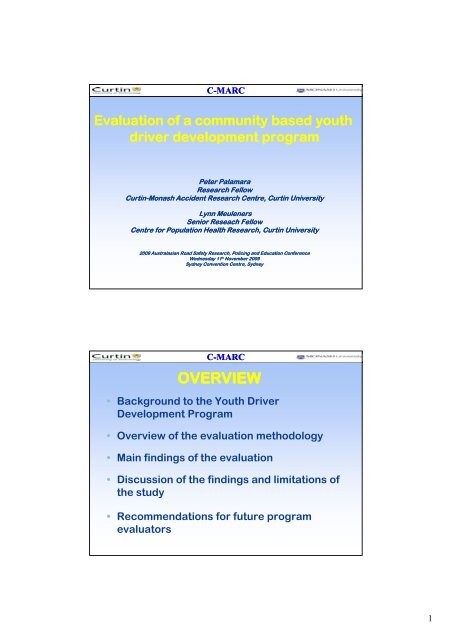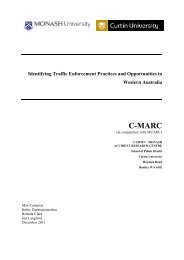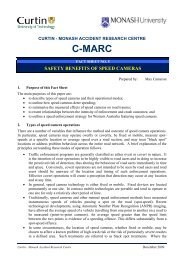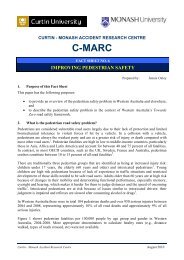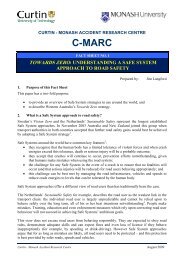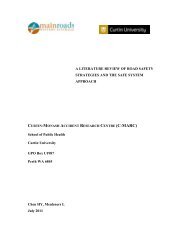Evaluation of a community based youth driver development program
Evaluation of a community based youth driver development program
Evaluation of a community based youth driver development program
You also want an ePaper? Increase the reach of your titles
YUMPU automatically turns print PDFs into web optimized ePapers that Google loves.
C-MARC<br />
<strong>Evaluation</strong> <strong>of</strong> a <strong>community</strong> <strong>based</strong> <strong>youth</strong><br />
<strong>driver</strong> <strong>development</strong> <strong>program</strong><br />
Peter Palamara<br />
Research Fellow<br />
Curtin-Monash Accident Research Centre, Curtin University<br />
Lynn Meuleners<br />
Senior Reseach Fellow<br />
Centre for Population Health Research, Curtin University<br />
2009 Australasian Road Safety Research, Policing and Education Conference<br />
Wednesday 11 h November 2009<br />
Sydney Convention Centre, Sydney<br />
C-MARC<br />
OVERVIEW<br />
• Background to the Youth Driver<br />
Development Program<br />
• Overview <strong>of</strong> the evaluation methodology<br />
• Main findings <strong>of</strong> the evaluation<br />
• Discussion <strong>of</strong> the findings and limitations <strong>of</strong><br />
the study<br />
• Recommendations for future <strong>program</strong><br />
evaluators<br />
1
C-MARC<br />
YOUTH DRIVER DEVELOPMENT<br />
PROGRAM<br />
• Established 1998, operates primarily in the Sth. West<br />
region around Bunbury<br />
• Targets high school students (Years 10 and 11) in prelearner<br />
and learner period; ages 15-16 years<br />
• ~N=2,100 students completed the <strong>program</strong> 1998-2006<br />
• Develop ‘safer’ on-road behaviours through attitudinal<br />
change<br />
C-MARC<br />
YOUTH DRIVER DEVELOPMENT<br />
PROGRAM<br />
• ‘Usual’ <strong>program</strong>:<br />
1 theory, 4 practical modules delivered d over 20 school hours<br />
On and <strong>of</strong>f road and classroom activities<br />
Delivered by pr<strong>of</strong>essional <strong>driver</strong> training organisation<br />
• Variety <strong>of</strong> training and education topics, eg.,:<br />
Road rules; vehicle control skills; high speed driving;<br />
H d ti i i ht t i i t d t d<br />
Hazard perception; insight training to understand<br />
limitations<br />
Effects <strong>of</strong> alcohol, speed, fatigue, <strong>driver</strong> distractions<br />
Seat belt use; risk taking and <strong>youth</strong>ful motivation<br />
2
C-MARC<br />
YOUTH DRIVER DEVELOPMENT<br />
PROGRAM<br />
• Program costs are ‘subsidised’ at $175<br />
• State government funding totaling $275,000 (June<br />
2008)<br />
• Other financial and ‘in-kind’ support from the<br />
<strong>community</strong><br />
• Strong financial, political, and <strong>community</strong> commitment<br />
to and support for the <strong>program</strong>…….despite the<br />
absence <strong>of</strong> demonstrated <strong>program</strong> efficacy<br />
C-MARC<br />
YDDP EVALUATION<br />
Null Hypothesis for the evaluation<br />
The is no significant difference between YDDP <strong>driver</strong>s (the exposed<br />
‘cohort’) and a comparable group <strong>of</strong> non-YDDP <strong>driver</strong>s (nonexposed<br />
‘controls’) in their involvement 12 months post-licensing<br />
for:<br />
Police recorded crashes<br />
Police issued Traffic Infringement Notices<br />
Police issued Traffic Infringement Notices<br />
Court appearances for traffic <strong>of</strong>fences (ie., convictions)<br />
Driver licence cancellations and suspensions<br />
3
C-MARC<br />
METHODOLOGY<br />
C-MARC<br />
STUDY DESIGN AND DRIVERS<br />
• Retrospective ‘cohort’ study with frequency matched<br />
‘control’ (comparison) )group<br />
• Frequency matched on <strong>driver</strong> sex, age at licensure,<br />
and year <strong>of</strong> licensure<br />
• ‘Cohort’ <strong>driver</strong>s taken from a listing <strong>of</strong> <strong>program</strong><br />
participants i t 1998-2005 (June)<br />
• ‘Control’ <strong>driver</strong>s drawn from those licensed in the<br />
Bunbury and surrounding areas<br />
4
C-MARC<br />
Driver Characteristics<br />
YDDP Cohort<br />
(n=1,095)<br />
‘Controls’<br />
(n=2,189)<br />
n % n %<br />
Sex<br />
Male 549 50.1 1097 50.1<br />
Female 546 49.9 1092 49.9<br />
Age at licensing<br />
17 years 842 76.9 1967 89.9<br />
18+ years 253 23.1 222 10.11<br />
Year <strong>of</strong> licensing<br />
1998-2001 (pre-GDTL) 300 27.4 627 28.6<br />
2002-2005(June) (GDTL) 795 72.6 1562 71.4<br />
C-MARC<br />
DRIVING OUTCOMES AT 12-MONTHS<br />
• Crash involvement<br />
Use MRWA police recorded crash dataset<br />
• Traffic Infringement Notices<br />
WA Police Business Intelligence Office records <strong>of</strong><br />
infringement notices issues<br />
• Court presentations for traffic <strong>of</strong>fences<br />
WA Police Business Intelligence Office records <strong>of</strong><br />
presentations before the WA courts<br />
• Driver licence suspensions and cancellations<br />
Licensing WA/WA Police records<br />
5
C-MARC<br />
RESULTS<br />
C-MARC<br />
POLICE RECORDED CRASHES<br />
• 9.4% control <strong>driver</strong>s v’s 11.3% cohort <strong>driver</strong>s crashed<br />
• Most crashed <strong>driver</strong>s (94.6% and 94.3%) involved in<br />
one crash<br />
• Conditional fixed effects logistic regression for:<br />
All <strong>driver</strong>s: OR 1.25; 95%CI 0.99-1.59; P 0.059 (NS)<br />
Males: OR 1.40; 95%CI 1.01-1.95; P 0.039<br />
Licence 18+ years: OR 1.40; 95%CI 1.01-1.95; P 0.039<br />
Licensed 2002-2005: OR 1.49; 95%CI 1.13-1.97; P 0.005<br />
Adjusted OR less than 1.00 indicate lower odds <strong>of</strong> crashing for YDDP <strong>driver</strong>s compared with control <strong>driver</strong>s<br />
6
C-MARC<br />
TRAFFIC INFRINGEMENT NOTICES<br />
• 35.4% control <strong>driver</strong>s v’s 33.3% cohort <strong>driver</strong>s incurred<br />
one or more TINS<br />
• Conditional fixed effects negative binomial regression for:<br />
All <strong>driver</strong>s: IRR 0.88; 95%CI 0.78-1.02.; P 0.054 (NS)<br />
Males: IRR 0.84; 95%CI 0.72-0.98; P 0.027<br />
Licence 17 years: IRR 0.85; 95%CI 0.75-0.98; P 0.024<br />
Adjusted IRR less than 1.00 indicate lower incidence <strong>of</strong> TINS for YDDP <strong>driver</strong>s compared with control <strong>driver</strong>s<br />
C-MARC<br />
COURT PRESENTED TRAFFIC OFFENCES<br />
• 4.4% control <strong>driver</strong>s v’s 3.5% cohort <strong>driver</strong>s appeared<br />
before the courts for one or more <strong>of</strong>fences<br />
• 33.8% control <strong>driver</strong> <strong>of</strong>fences drink-driving; 45% cohort<br />
<strong>driver</strong> <strong>of</strong>fences careless driving<br />
• Conditional fixed effects negative binomial regression for:<br />
All <strong>driver</strong>s: IRR 0.70; 95%CI 0.44-1.03.; P 0.07 (NS)<br />
Females: IRR 0.31; 95%CI 0.10-0.92; P 0.035<br />
Licence 17 years: IRR 0.37; 95%CI 0.21-0.65; P 0.001<br />
Adjusted IRR less than 1.00 indicate lower incidence <strong>of</strong> TINS for YDDP <strong>driver</strong>s compared with control <strong>driver</strong>s<br />
7
C-MARC<br />
LICENCE CANCELLATION or SUSPENSION<br />
• 4.5% control <strong>driver</strong>s v’s 3.2% cohort <strong>driver</strong>s had their<br />
licence cancelled or suspended<br />
• Conditional fixed effects logistic regression for:<br />
All <strong>driver</strong>s: OR 0.62; 95%CI 0.41-0.92; P 0.02<br />
Licence 17 years: OR 0.34; 95%CI 0.19 19-0.61; P 0.0000<br />
Licensed 1998-2001: OR 0.27; 95%CI 0.07-0.92; P 0.038<br />
Adjusted OR less than 1.00 indicate lower odds <strong>of</strong> licence cancellation/suspension for YDDP <strong>driver</strong>s compared<br />
with control <strong>driver</strong>s<br />
C-MARC<br />
DISCUSSION<br />
8
C-MARC<br />
WHAT DO THE RESULTS SUGGEST?<br />
• Reject the Null Hypothesis <strong>of</strong> no difference between all<br />
<strong>program</strong> cohort and control <strong>driver</strong>s for one driving<br />
outcome only: licence cancellation/suspensions<br />
• Excluding crashes, evidence to suggest a differential<br />
impact <strong>of</strong> the <strong>program</strong> on participants evaluated<br />
• Participants licensed at 17 years evidenced lower<br />
incidence <strong>of</strong> TINS; court presented <strong>of</strong>fences, and odds<br />
<strong>of</strong> licence cancellation/suspension<br />
Males licensed under the GDTL 2002-2005<br />
Females licensed 1998-2005, excluding TINS<br />
C-MARC<br />
HOW VALID ARE THESE FINDINGS?<br />
• Design <strong>of</strong> the study:<br />
No randomization <strong>of</strong> participants to conditions,<br />
hence possible bias in the groups on variables that<br />
might interact with the <strong>program</strong> and/or influence<br />
driving outcomes<br />
• Loss to follow-up<br />
Evaluated only 52% <strong>of</strong> YDDP participants, 1998-<br />
2005<br />
How representative are these <strong>driver</strong>s <strong>of</strong> the entire<br />
population <strong>of</strong> <strong>program</strong> participants?<br />
9
C-MARC<br />
HOW VALID ARE THESE FINDINGS?<br />
• Correct identification and classification <strong>of</strong> <strong>program</strong><br />
participants:<br />
Difficulty in linking YDDP participant information<br />
with licensing records held by WA Police<br />
• Correct follow-up period and information post licence:<br />
Some difficulty in establishing the correct date <strong>of</strong><br />
initia licensure for cohort and control <strong>driver</strong>s<br />
C-MARC<br />
WOULD OTHERS BENEFIT FROM THE<br />
PROGRAM?<br />
• Can the observed findings be generalised to<br />
other groups <strong>of</strong> <strong>program</strong> participants, in<br />
different settings?<br />
• No attempt to investigate which elements <strong>of</strong> the<br />
<strong>program</strong> should be retained, revised or deleted<br />
to improve driving outcomes for future<br />
participants<br />
10
C-MARC<br />
RECOMMENDATIONS FOR FUTURE PROGRAM<br />
EVALUATORS<br />
• Accurate recording <strong>of</strong> participant p details<br />
• Appropriate Informed Consent documentation<br />
for data release<br />
• Appropriate documentation <strong>of</strong> <strong>program</strong> content<br />
• Agreed understanding <strong>of</strong> the behavioural<br />
descriptors <strong>of</strong> intended <strong>program</strong> aims and<br />
outcomes<br />
• Prospective, not retrospective, planning for the<br />
evaluation; ‘build in’ evaluation planning<br />
C-MARC<br />
QUESTIONS?<br />
11


